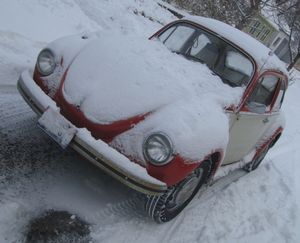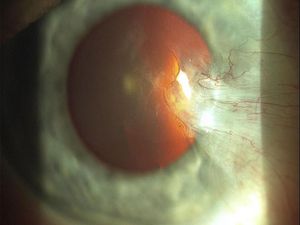Now that there’s snow on the ground, I’ve garaged my 4X4 pickup truck and switched to driving my vintage VW Beetle instead. Even though a vintage Beetle seems like a poor choice of vehicle to drive in snowy weather, it’s worth remembering that these German cars were tested on Alpine roads and can handle extreme driving conditions without a lot of sliding.
The low center of gravity combined with a engine in the back gives these cars plenty of winter traction especially when outfitted with studded all weather tires. A classic Beetle can easily manage a drive through 6-8″ inches of snow though deeper snow often means putting on a set of chains.
Driving a classic VW Beetle in the snow does require a bit of skill along with some winter tools. Here are a few “tips and tricks” that I’ve picked up over the years.
Indoor ice scraper. Classic VW Beetles aren’t known for efficient interior heaters which is why a Beetle owner needs a interior ice scraper as well as an exterior one. I prefer using an old credit card to scrape the inside of my windows when they ice up. The small size of a credit card is easy to store on the visor and much easier to use than a long handled scraper.
A couple of other tips to remember: Washing the inside of the windshield with rubbing alcohol will minimize icing up. I also keep a couple of rags in the glovebox to use for wiping down interior condensation from the windows once they’ve thawed.
Let the car warm up for 5 minutes before driving off. Unlike newer cars that no longer require a warming up period, vintage Beetles will benefit from a 5 minute ‘warm up’ before driving off. While it’ll be another 10 minutes before the heat finally kicks on, the initial warmup will start the jump start the defrosting action and prevent the car from stalling once you pull out of the driveway and into the street.
Downshift in lieu of braking. One big advantage in driving a stick shift on icy or snowy roads is the ability to use the gears to slow down instead of the brakes. I routinely downshift from second to first gear when approaching stop signs to prevent sliding. To avoid stopping altogether, I begin downshifting about 150 yards away from the light in the hopes that it will change by the time I get there. This tip is especially useful on sloped intersections where icy conditions make it tough to pull forward from a complete stop.
Take off in second gear. If you find yourself stopped in an icy intersection, slipping can be minimized by taking off in second gear. Accelerating from second gear reduces power and increases the traction.
Keep the speed around 25 mph in town. For my 1971 Super Beetle, the optimal driving speed around snowy roads in town is about 25 miles an hour when driving on unstudded all-weather tires. Anything faster than that, the car tends to slide to the left. This can be corrected by taking the foot off the gas, putting in the clutch, and removing your hand off the steering wheel for a brief second so that the tires can straighten out.
Vintage Beetles might not be the warmest or safest car to drive in the winter but they are certainly reliable when it comes to driving through snow. As long as you stay off the freeways and drive at a modest speed through town, these classic little cars will get you where you need to go.
More by this contributor:
How to stop your car windows from freezing up.
How to hang curtains in a VW microbus.
How to stop car windows from freezing.


